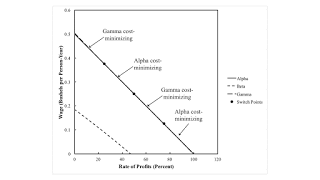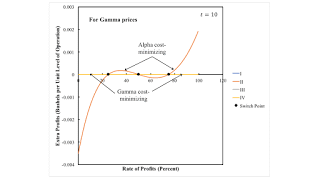Figure 1: A Pattern Diagram with Triple Switching In demonstrating the lack of foundation for claims of the Austrian school about the supposed relationships between a greater supply of capital, a consequent lower rate of profits, and a longer period of production, I have so far only presented examples in which the economic life of an existing machine can be extended or truncated. Schefold (1980: 170) interprets a more roundabout technique as one in which a long-lived machine is used to produce a finished good that previously was produced directly without the aid of fixed capital or, at least, with a different and inferior machine. The example in this post extends Schefold's illustration of the difficulty in sustaining the Austrian claim. I am disappointed that in briefly exploring the
Topics:
Robert Vienneau considers the following as important: Austrian School Of Economics, Example in Mathematical Economics, Sraffa Effects
This could be interesting, too:
Robert Vienneau writes Austrian Capital Theory And Triple-Switching In The Corn-Tractor Model
Robert Vienneau writes Double Fluke Cases For Triple-Switching In The Corn-Tractor Model
Robert Vienneau writes The Emergence of Triple Switching and the Rarity of Reswitching Explained
Robert Vienneau writes Recap For A Triple -Switching Example
| Figure 1: A Pattern Diagram with Triple Switching |
In demonstrating the lack of foundation for claims of the Austrian school about the supposed relationships between a greater supply of capital, a consequent lower rate of profits, and a longer period of production, I have so far only presented examples in which the economic life of an existing machine can be extended or truncated. Schefold (1980: 170) interprets a more roundabout technique as one in which a long-lived machine is used to produce a finished good that previously was produced directly without the aid of fixed capital or, at least, with a different and inferior machine. The example in this post extends Schefold's illustration of the difficulty in sustaining the Austrian claim.
I am disappointed that in briefly exploring the parameter space specified by coefficients of production, I was unable to find an example in which wages curves on the frontier were easily distinguishable by the eye. I did like that Figure 1 came out one way I knew could bring about triple switching.
The second, third, and fourth processes in the technology (Tables 1 and 2) constitute the corn sector. In Process II, corn is produced from inputs of labor and corn, without fixed capital. The Alpha technique (Table 3) consists of Process II alone. A machine sector, composed of Process I, exists in the Beta and Gamma techniques. The technical life of the machine is two years. The machine is truncated to one year in the Beta technique
| Input | Process | |||
| (I) | (II) | (III) | (IV) | |
| Labor | a0,1 | a0,2 | a0,3 | a0,4 |
| Corn | a1,1 | a1,2 | a1,3 | a1,4 |
| New Machines | 0 | 0 | 1 | 0 |
| Old Machines | 0 | 0 | 0 | 1 |
| Output | Process | |||
| (I) | (II) | (III) | (IV) | |
| Corn | 0 | 1 | b1,3 = 1/2 | b1,4 = 1/2 |
| New Machines | 1 | 0 | 0 | 0 |
| Old Machines | 0 | 0 | 1 | 0 |
| Techniques | Processes |
| Alpha | (II) |
| Beta | (I), (III) |
| Gamma | (I), (III), (IV) |
Suppose the coefficients of production for inputs of labor and circulating capital decrease ten percent per year. Figure 1 shows the variation in the choice of technique for a specific configuration of coefficients of production. Schefold's example of triple switching occurs at t = 10. Figure 2 graphs the wage frontier here, in which the wage curves for the Alpha and Gamma techniques are difficult for the eye to distinguish. Figure 3 shows extra profits in operating the second process at Gamma prices. Triple switching is more apparent here.
| Figure 2: Wage Frontier for Triple Switching |
| Figure 3: Extra Profits at Gamma Prices |
With this specification of parameters and technical progress, the non-roundabout process Alpha eventually replaces the roundabout process Gamma, whatever the distribution of income. Triple switching appears in the middle of the three transient regions. The patterns of switch points illustrate one manner in which triple-switching can appear. If the pattern over the wage axis were to arise before the second reswitching pattern, the region in which triple-switching occurs would be followed by a region with double switching. With more techniques, one of the switch points could be replaced on the frontier in a three-technique pattern, instead of eventually vanishing over an axis. At any rate, this example continues to illustrate how combinations of patterns of switch points can illuminate the effects of technical change.
In Regions 2, 3, and 4, the Alpha technique, in which corn is produced without the use of a machine, is cost-minimizing at the highest rate of profits, where the wage is zero. Around the only switch point in each of Regions 2 and 4, a lower rate of profits is indeed associated with a more roundabout technique, and the more roundabout technique has a higher level of consumption per person-year in a stationary state. The Austrian claim is also illustrated at the lowest and highest switch point in Region 2. But it is invalidated for the middle switch point. Around this switch point, a lower rate of profits is associated with the replacement of a roundabout technique by the direct production of the consumer commodity.
This numerical example re-iterates that no necessary connection exists between employing or lengthening the economic life of a machine and an increase in the use of 'capital'. Bohm-Bawerk (1959) was incorrect not merely because of the difficulty of defining a quantitative measure of the average period of production. His intuition, and not just his, on how prices work was itself incorrect.
 Heterodox
Heterodox



